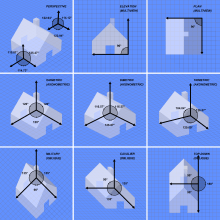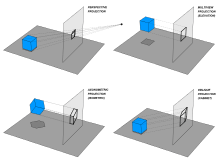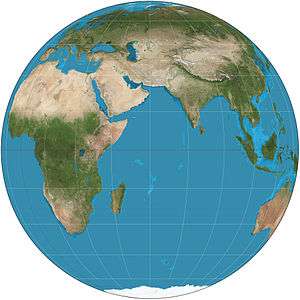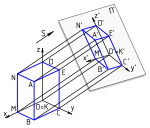Orthographic projection
Orthographic projection (sometimes orthogonal projection), is a means of representing three-dimensional objects in two dimensions. It is a form of parallel projection, in which all the projection lines are orthogonal to the projection plane,[1] resulting in every plane of the scene appearing in affine transformation on the viewing surface. The obverse of an orthographic projection is an oblique projection, which is a parallel projection in which the projection lines are not orthogonal to the projection plane.
The term orthographic is sometimes reserved specifically for depictions of objects where the principal axes or planes of the object are also parallel with the projection plane,[1] but these are better known as multiview projections. Furthermore, when the principal planes or axes of an object in an orthographic projection are not parallel with the projection plane, but are rather tilted to reveal multiple sides of the object, the projection is called an axonometric projection. Sub-types of multiview projection include plans, elevations and sections. Sub-types of axonometric projection include isometric, dimetric and trimetric projections.
A lens providing an orthographic projection is known as an object-space telecentric lens.
Geometry


A simple orthographic projection onto the plane z = 0 can be defined by the following matrix:
For each point v = (vx, vy, vz), the transformed point would be
Often, it is more useful to use homogeneous coordinates. The transformation above can be represented for homogeneous coordinates as
For each homogeneous vector v = (vx, vy, vz, 1), the transformed vector would be
In computer graphics, one of the most common matrices used for orthographic projection can be defined by a 6-tuple, (left, right, bottom, top, near, far), which defines the clipping planes. These planes form a box with the minimum corner at (left, bottom, -near) and the maximum corner at (right, top, -far).
The box is translated so that its center is at the origin, then it is scaled to the unit cube which is defined by having a minimum corner at (-1,-1,-1) and a maximum corner at (1,1,1).
The orthographic transform can be given by the following matrix:
which can be given as a scaling followed by a translation of the form
The inversion of the Projection Matrix, which can be used as the Unprojection Matrix is defined:
Sub-types

With multiview projections, up to six pictures of an object are produced, with each projection plane parallel to one of the coordinate axes of the object. The views are positioned relative to each other according to either of two schemes: first-angle or third-angle projection. In each, the appearances of views may be thought of as being projected onto planes that form a six-sided box around the object. Although six different sides can be drawn, usually three views of a drawing give enough information to make a three-dimensional object. These views are known as front view, top view and end view. Other names for these views include plan, elevation and section.
The term axonometric projection (not to be confused with the related principle of axonometry, as described in Pohlke's theorem) is used to describe the type of orthographic projection where the plane or axis of the object depicted is not parallel to the projection plane, and where multiple sides of an object are visible in the same image.[2] It is further subdivided into three groups: isometric, dimetric and trimetric projection, depending on the exact angle at which the view deviates from the orthogonal.[1][3] A typical characteristic of axonometric projection (and other pictorials) is that one axis of space is usually displayed as vertical.
Cartography

An orthographic projection map is a map projection of cartography. Like the stereographic projection and gnomonic projection, orthographic projection is a perspective (or azimuthal) projection, in which the sphere is projected onto a tangent plane or secant plane. The point of perspective for the orthographic projection is at infinite distance. It depicts a hemisphere of the globe as it appears from outer space, where the horizon is a great circle. The shapes and areas are distorted, particularly near the edges.[4][5]
The orthographic projection has been known since antiquity, with its cartographic uses being well documented. Hipparchus used the projection in the 2nd century BC to determine the places of star-rise and star-set. In about 14 BC, Roman engineer Marcus Vitruvius Pollio used the projection to construct sundials and to compute sun positions.[5]
Vitruvius also seems to have devised the term orthographic (from the Greek orthos (= “straight”) and graphē (= “drawing”) for the projection. However, the name analemma, which also meant a sundial showing latitude and longitude, was the common name until François d'Aguilon of Antwerp promoted its present name in 1613.[5]
The earliest surviving maps on the projection appear as woodcut drawings of terrestrial globes of 1509 (anonymous), 1533 and 1551 (Johannes Schöner), and 1524 and 1551 (Apian).[5]
References
- 1 2 3 Maynard, Patric (2005). Drawing distinctions: the varieties of graphic expression. Cornell University Press. p. 22. ISBN 0-8014-7280-6.
- ↑ Mitchell, William; Malcolm McCullough (1994). Digital design media. John Wiley and Sons. p. 169. ISBN 0-471-28666-4.
- ↑ McReynolds, Tom; David Blythe (2005). Advanced graphics programming using openGL. Elsevier. p. 502. ISBN 1-55860-659-9.
- ↑ Snyder, J. P. (1987). Map Projections—A Working Manual (US Geologic Survey Professional Paper 1395). Washington, D.C.: US Government Printing Office. pp. 145–153.
- 1 2 3 4 Snyder, John P. (1993). Flattening the Earth: Two Thousand Years of Map Projections pp. 16–18. Chicago and London: The University of Chicago Press. ISBN 0-226-76746-9.
External links
| Wikimedia Commons has media related to Orthographic projections. |
